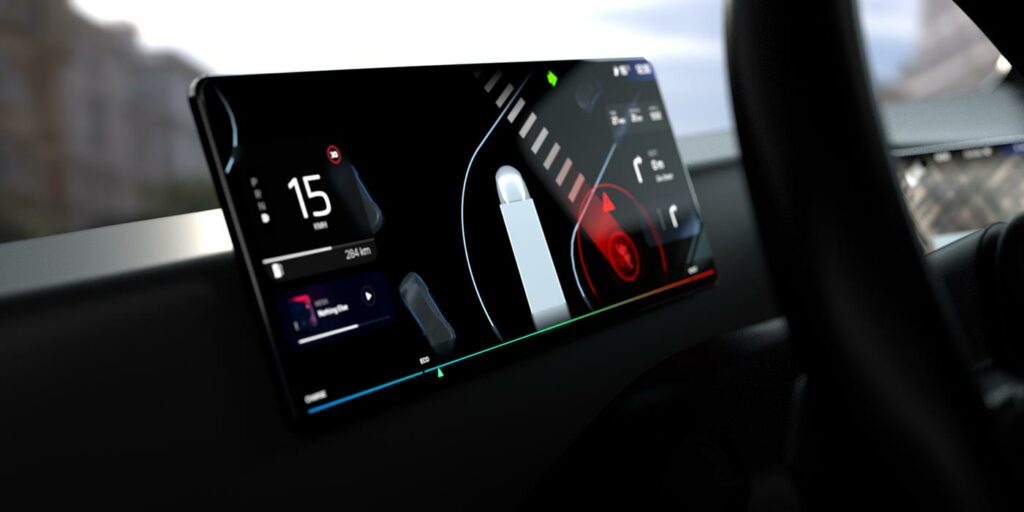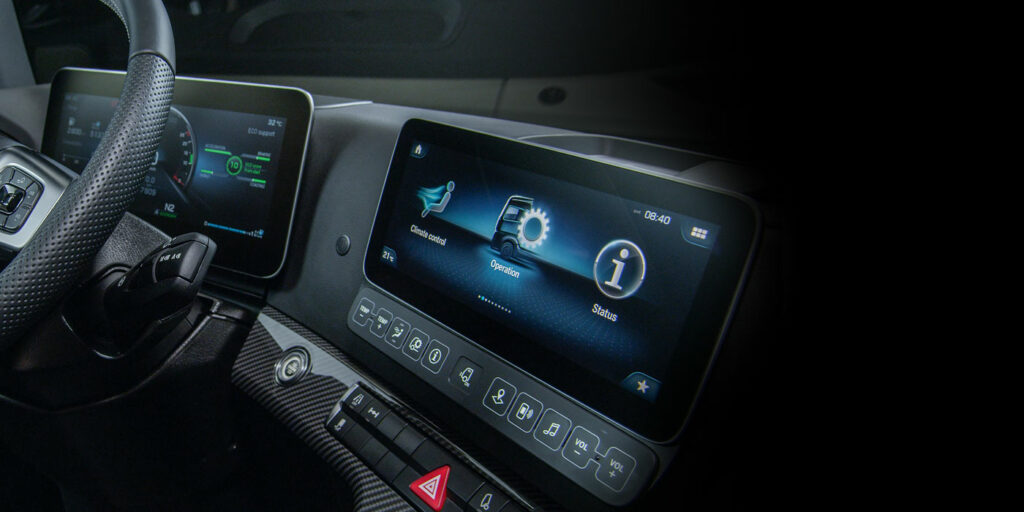Jump behind the wheel of many of today’s new commercial trucks and you’ll be dazzled by the driver display, but today’s cockpit is more than just aesthetics. Safety is also a careful consideration behind the design. Commercial vehicle manufacturers are increasingly adding high-definition digital instrument clusters—some with screens as large as 15 in. across—to display critical information with high-quality real-time 3D graphics. As a result, cockpit digital real estate dedicated to the user interface (UI) is expanding, both in capabilities and size. As the trucking industry rapidly adapts innovative technology, reconfigurable digital displays in instrument clusters and in-vehicle infotainment (IVI) screens—collectively known as the human machine interface (HMI)—are growing in popularity and importance and have great potential to enhance safety on the highway and in the last mile.
This follows a trend that began in the passenger vehicle market, where automakers are utilizing large digital screens with bold high-resolution graphics that enhance brand identity. While still in their infancy in the commercial vehicle market, digital screens are beginning to prove their value to manufacturers as they seek to enhance the driving experience and strengthen brand identity.
Safety: More than eyes on the road
Filled bumper-to-bumper with electronics, modern trucks have literally become sophisticated computers on wheels. With so much information gathered and transmitted to the cockpit, it’s important to provide drivers with accurate information at the precise time it’s needed without compromising safety. Reducing driver distraction is vital and technologies such as lane-keeping assist and adaptive cruise control are already helping to keep drivers focused and alert. But safety is much more than simply eyes on the road.
Commercial vehicle manufacturers can benefit from lessons learned over the past decade in the passenger vehicle market, because many suppliers are developing advanced digital cockpits for both markets. An “intelligent cockpit”—harnessing technology to create a well-designed HMI that fully utilizes digital displays and advanced visualization—takes safety to an entirely new level.
For example, today’s trucks are equipped with advanced driver-assistance systems (ADAS) that issue audible warnings or haptic alerts to enhance vehicle safety. In an intelligent cockpit, information and data from the ADAS cameras and sensors are combined to offer a 360-degree view around the truck and provide the driver with clear visual cues of potential dangers.
Many government and non-profit agencies, including the U.S. Department of Transportation (DOT), globally are focused on last-mile road safety with the goal to significantly reduce traffic fatalities and serious injuries, specifically in urban environments. The ability to know in detail what is around the truck, specifically in their blind spots and behind them, can help drivers avoid hitting other vehicles and pedestrians.
As ADAS technology continues to evolve, so too will the importance of the intelligent cockpit. With the next generation of ADAS, the driver will be able to see on a digital display a vehicle rapidly approaching the truck from behind in a highway setting, and will receive data on the vehicle’s speed and time until it reaches the back of the truck. In urban environments, the location and movement of pedestrians can be shown in a detailed graphical rendering of the vehicle’s immediate environment. Such critical information will allow the driver time to take proactive measures, if needed, to avoid accidents. Even when the proactive measures are taken automatically by onboard safety systems, the driver needs to be informed in an appropriate, contextual way.

UX design and sophistication
Increasing screen size in trucks provides drivers with more information and a clear view of their surroundings. Camera projection and augmentation with synthetic vision is one big reason to have more display real estate. Providing a wide field of view on blind-spot detectors is a feature highly requested by drivers.
Increasing screen size also adds importance to prioritizing what, and how much, information is shown and how it is presented to the driver. A well-designed UX provides critical data with sophistication that supports the driver, with safety in the forefront, rather than overwhelming the driver with an extensive static set of information.
There are times when the driver needs an abundance of facts, such as during the pre-trip check of critical vehicle systems. In other scenarios, when the driver really needs to concentrate on the road, it is important to minimize the amount of information on the screen. It is critical that the HMI deliver operational convenience and display comfort, providing the driver with a seamlessly connected workspace with digital services that increase operator and fleet efficiency.
The right tools
All fleet operators realize the importance of having the right tools for the job. The same applies to HMI development for commercial vehicles. Rightware’s Kanzi user interface tools facilitate a productive and efficient process for creative design and software engineering to develop a signature UI, accelerating HMI development, providing significant cost savings to complex projects, and achieving the best possible digital cockpit user experience. Kanzi is used by more than 50 automotive brands for rapid HMI development.
Global truck manufacturers have recognized the unique benefits of Kanzi software in the design and development of truly advanced user interfaces. The commercial vehicle segment in North America and Europe recently began using Kanzi software to power interactive multimedia cockpits. The Mercedes-Benz Actros flagship was the first commercial vehicle powered by Kanzi.
Ville Kolppo is the design director, Kanzi Services, with Rightware.













